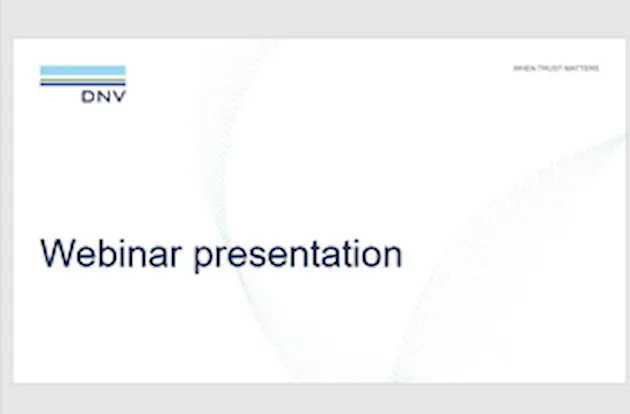Predicting the fatigue life of an offshore new build or the remaining fatigue life of an existing asset are key factors when deciding on the as-built design or thumbs up/down for life extension work. There are several fatigue analysis methods available supporting the requirements of standards like DNV, ISO or API.
In this webinar video, we introduce you to the fatigue methods provided by Sesam for design and life extension of offshore foundations in the wind and oil and gas industries. We discuss two of them in detail and explain the criticality of method selection for wave force linearization. Kevin Drake, Principal Engineer at Noble Denton (a part of DNV), presents a case study investigating the influence of the different analysis methods available in Sesam upon fatigue damage predictions for jack-up rigs.
We also discuss using time-domain approaches in the fatigue calculations of offshore foundations supporting wind turbines.
Watch this webinar video to learn about the fatigue analysis methods in Sesam and understand the essential differences between the so-called ‘spectral’ and ‘stochastic’ methods to predict wave-induced fatigue damage.
Topics:
- Overview of fatigue analysis methods supported by Sesam
- ‘Wave-induced stochastic fatigue’ and ‘wave-induced spectral fatigue’
- Case studies for a jack-up rig with consideration of nonlinear drag and variable submergence
- ‘Wave-induced time history fatigue’ and its application to wind turbine structures
Research background:
The webinar is based on the article “An investigation into the influence of analysis methods upon fatigue damage predictions for jack-up rigs”, by N. K. Uthamanthil & K. R. Drake, published on Ships and Offshore Structures in April 2021. The study investigates the dynamic spectral fatigue analysis of a representative jack-up rig for long term deployments in 30m and 70m water depth in the North Sea. Transfer functions are computed using two approaches: regular waves of constant steepness with capping of wave height at low frequencies; stochastic linearization based on a single sea state per wave scatter diagram. It is concluded that the latter method is insufficient to provide an adequate characterization of nonlinear drag forces for the dynamic spectral fatigue analysis of jack-up rigs. Super-harmonic resonance effects, due to non-linearities associated with variable submergence and drag forces, are found to be significant when computing transfer functions of structural dynamic response.
The webinar is relevant for:
Offshore structural engineers, group leaders, engineering managers, and technical authorities responsible for the design, re-qualification or conversion of fixed and mobile offshore assets intended for use in the oil and gas or offshore wind sectors.
It is especially relevant to engineers dealing with drag-dominated dynamically-sensitive structures operating in harsh wave environments.
Why watch?
In this webinar recording, you will learn about:
- The importance of dealing with nonlinear drag and variable submergence during the calculation of hydrodynamic loads.
- The essential differences between the Sesam options referred to as ‘wave-induced spectral fatigue’ and ‘wave-induced stochastic fatigue’ and their influence on fatigue damage prediction.
- The Sesam option ‘wave-induced time history fatigue’, which allows the inclusion of wave force nonlinearities due to drag and variable submergence as well as structural dynamics. This method is used mainly by engineers in the offshore wind sector.
Presenters:
Ole Jan Nekstad, Product Director for Sesam, took his M.Sc. in offshore engineering from NTH (now NTNU), Trondheim, Norway in 1981. He has since then worked for DNV and has done numerous FE analyses of ships, semi-submersibles, GBS and jackets. He joined the software part of DNV in 1989 and has since 1994 been looking after Sesam as its product director. He was project manager of the JIP “Sesam 2000” that led to the Sesam today.
Kevin Drake studied civil engineering as an undergraduate at Leeds University and ocean engineering as a research student at University College London (UCL). After obtaining his PhD, he worked for Shell for five years before joining Earl and Wright, where he worked for a further six years. He is a chartered civil engineer, and his industrial experience includes the design, fabrication, installation and decommissioning of various offshore structures for the oil and gas industry. He returned to UCL in 1995 as a lecturer. In 2000 he was an expert witness for the UK government’s Re-hearing of the Formal Investigation into the loss of the MV Derbyshire. He returned to industrial practise in 2013. He is currently working within the Jack-up, Geotechnical and Metocean team of Noble Denton marine services (part of DNV).
Christian Wood, Product Line Director for Offshore Structures and Renewable Energy Software at DNV, studied MEng Aerospace Engineering and EngD from the Ship Science department at the University of Southampton. Christian worked for seven years at Frazer-Nash Consultancy in their Fluids and Acoustics consultancy team, solving problems involving fluid flow, turbulence, combustion, heat transfer and vibrations. He is a chartered mechanical engineer with experience in floating wind, oil and gas, naval marine, and aerospace sectors. Christian joined DNV in 2018 and now leads the offshore structures and renewable energy software business, including Sesam, Bladed, Nauticus, WindFarmer and SolarFarmer products.

Webinar presentations slides
Download the slides

Questions and answers
Download the document
Sesam webinars
Watch other recorded webinars
Any questions?
Speak to an expert
Know what you need?
Buy online
